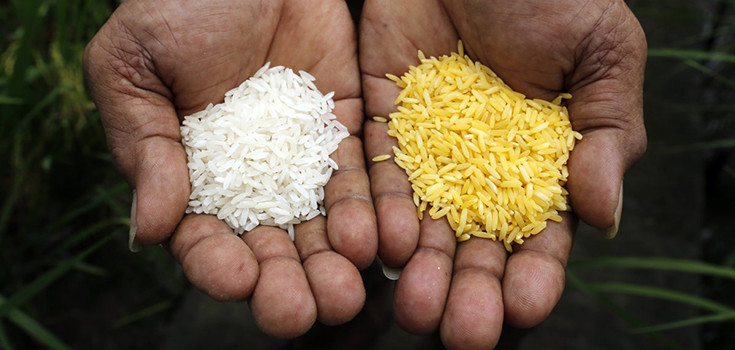Miracle” Golden Rice Could Cause Birth Defects, Warns Indian Scientist
“Miracle” Golden Rice Could Cause Birth Defects, Warns Indian Scientist
“Miracle” Golden Rice Could Cause Birth Defects, Warns Indian Scientist
Scientists in Bangladesh are preparing to conduct field tests of Golden Rice , the world’s first genetically engineered, vitamin A-enriched rice, before putting into production .
. The crop is being touted as one answer to the problem of micronutrient deficienciesaround the world, but an Indian scientist (among others) is warning that Golden Rice poses a serious threat to human health. [1]
According to the Golden Rice Project, vitamin A deficiency is prevalent among the poor whose diets are primarily composed of rice and other carbohydrate-rich foods containing too few micronutrients. The situation is especially dire in Southeast Asia and Africa. About 250 million preschool children are affected by vitamin A deficiency (VAD). The group says that providing children with vitamin A could prevent about a third of all under-5 deaths.
Enter, Golden Rice.
“Rice containing provitamin A could substantially reduce the problems described above. This can only be achieved using genetic engineering because there is no provitamin A in the rice seeds, even though it is present in the leaves. Thousands of rice varieties have been screened for this trait without success. Existing coloured rice varieties contain pigments that belong to a different chemical class.”
“Biofortified crops, like Golden Rice offer a long-term sustainable solution, because they do not require recurrent and complicated logistic arrangements once they have been deployed.”
Renowned Indian scientist Dr. Tusher Chakraborty has another view of this supposedly miracle crop, however. While speaking to the UNB at a workshop on Food Security and Modern Biotechnology on October 10, Dr. Chakraborty said that Golden Rice “may carry traces of retinoic acid derivatives which may cause teratogenicity – that means birth defects in general.”
Retinoic acid is a retinoid, a compound derived from retinol or vitamin A. Retinoids are used to treat skin conditions and cancer. While vitamin A is important in pregnancy, an overabundance of the nutrient can cause teratogensis, the production of birth defects in a developing embryo. Too much vitamin A or an excess of retinoids in pregnant women can result in malformationsto fetuses’ skulls, faces, limbs, eyes, and central nervous systems. [2] [3]
In addition to the targeted retinoic acid, the numerous other derivatives can be created in the transgenic rice that can trigger numerous unknown metabolic receptors in humans and lead to various health problems throughout life, he added.
Dr. Tusher, a member of State Council of Biotechnology, West Bengal, India, said: “Golden rice involves an unnecessary risk in the name of meeting vitamin A deficiency. It’s a move in the wrong direction, it’s a plot to divert the food cultureto the wrong route.”
According to the scientist, there are plenty of other vitamin A sources in South Asia, including indigenous rice varieties that are naturally enriched with vitamin A.
“It’s a culturally distorted concept of nutrition to interject four-five other things in the staple grain. Nutrition security means the diversity of nutritious food, not to have all the supplements in one grain.”
Dr. Tusher also says daily consumption of rice needed to tackle South Asia’s vitamin A deficiency is unrealistic – 1.5kg. That would mean eating more than 3 lb. of rice every day.
Business Insider(Featured image source)
| About Julie Fidler: | |
| Julie Fidler is a freelance writer, legal blogger, and the author of Adventures in Holy Matrimony: For Better or the Absolute Worst. She lives in Pennsylvania with her husband and two ridiculously spoiled cats. She occasionally pontificates onher blog. | |
Other Popular Stories:

Post a Comment